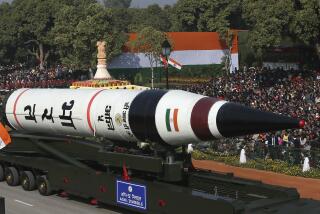India, Pakistan Said to Push Nuclear Arms Race
CHICAGO — India and Pakistan are much deeper into a nuclear arms race than previously thought, with India poised to test a hydrogen bomb and Pakistan developing an atomic bomb for use with its U.S.-made F-16 attack aircraft, researchers reported Sunday.
Scientists David Albright and Tom Zamora, writing in the June issue of the Chicago-based Bulletin of the Atomic Scientists, said West German investigations into illegal exports of nuclear technology have produced mounting evidence that both India and Pakistan “have even more extensive nuclear weapons research, development and production programs than previously thought.”
The two are affiliated with the Federation of American Scientists, a 5,000-member group concerned with the global arms race and other scientific issues affecting society. They based their article on a combination of U.S. government sources and published reports.
Pakistan will have produced enough weapons-grade uranium to make eight to 16 bombs by the end of 1990, the article said, while India already has enough plutonium for at least 40 to 50 nuclear weapons, with the likely capability to produce 15 new weapons annually during the next few years.
India exploded a 12-kiloton nuclear device in 1974, but “there is no concrete evidence” that either it or Pakistan has actually built and deployed nuclear weapons, the article said.
However, both Indian Prime Minister Rajiv Gandhi and Prime Minister Benazir Bhutto of Pakistan “appear unwilling or unable to constrain their nuclear weapons programs,” resulting in a nuclear standoff between the two nations, the authors said.
Danger to Region’s Security
If either country tests or deploys weapons at this point, the other will follow, posing a danger to the security of south Asia and perhaps undermining efforts to keep other countries such as Argentina and Brazil from joining the nuclear club, the article said.
“India probably decided several years ago to acquire the know-how to make a thermonuclear weapon (H-bomb) as a hedge against Pakistan’s growing atomic ability, and to be prepared to test such a device within a few months of a Pakistani nuclear test,” the report said.
“Both India and Pakistan have imported beryllium--a material useful in designing smaller, lighter and more sophisticated nuclear weapons,” the article added.
“Pakistan has acquired sophisticated tritium processing equipment from West Germany, and India is building a plant that will be able to produce large amounts of tritium,” it said. Tritium is used to enhance the explosive power of nuclear weapons.
“Pakistan is reported to have perfected the design of a nuclear aerial bomb for its U.S.-supplied F-16 attack aircraft, and India has apparently been working on the design of a nuclear aerial bomb since 1984,” the two scientists said.
“India is reportedly preparing to test an intermediate-range ballistic missile with a range of 1,500 miles; in February, Pakistan said it had test-fired two short-range missiles,” the article said.
More to Read
Sign up for Essential California
The most important California stories and recommendations in your inbox every morning.
You may occasionally receive promotional content from the Los Angeles Times.










